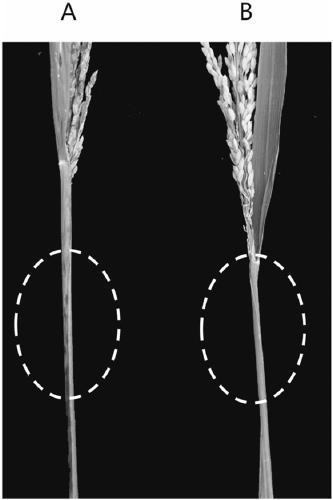Rice blast resistance gene pair TP22 and application thereof
A rice blast resistance gene, TP22 technology, applied in the field of genetic engineering, can solve problems such as ignoring disease resistance genes, and achieve the effect of expanding the resistance spectrum, enhancing resistance, and improving resistance
- Summary
- Abstract
- Description
- Claims
- Application Information
AI Technical Summary
Problems solved by technology
Method used
Image
Examples
Embodiment 1
[0035] Identification of Rice Blast Resistance Gene TP22
[0036] We searched for NBS-LRR gene pairs with a "head-to-head" structure in the Tetep genome, and constructed phylogenetic trees for their sequences and their homologous sequences in the Nipponbare, Tetep, and Brachypodium genomes to further confirm the pair relationship. A total of 43 disease-resistant genes were obtained in Tetep, and TP22 (chr11.fgenesh2445 / chr11.fgenesh2446) was one of the pairs, which had the following characteristics: (1) chr11.fgenesh2445 (sensing gene) and chr11.fgenesh2446 ( Auxiliary genes) belong to different branches with faster and slower evolution in the phylogenetic tree. (2) chr11.fgenesh2445 (sensing gene) has higher nucleotide polymorphism (π) and nucleotide difference (Dxy) than chr11.fgenesh2446 (auxiliary gene).
Embodiment 2
[0038] Isolation and Cloning of Rice Blast Resistance Gene TP22 (chr11.fgenesh2445 / chr11.fgenesh2446)
[0039] Using the Tetep genome and public database sequencing species Nipponbare as reference sequences, design cloning primers (both ends of the primers have enzyme cutting sites AscI) and fusion primers. For the primer sequence, refer to the sequence listing, the forward cloning primer sequence of chr11.fgenesh2445 is shown in SEQ ID NO: 7; the reverse cloning primer sequence is shown in SEQ ID NO: 8; the forward cloning primer sequence of chr11.fgenesh2446 is shown in SEQ ID NO Shown in: 9; Reverse cloning primer sequence is shown in SEQ ID NO: 10. The forward fusion primer sequence of chr11.fgenesh2445 is shown in SEQ ID NO:11; the reverse fusion primer sequence is shown in SEQ ID NO:12; the forward fusion primer sequence of chr11.fgenesh2446 is shown in SEQ ID NO:13; The reverse fusion primer sequence is shown in SEQ ID NO:14. Using the disease-resistant rice variety T...
Embodiment 3
[0041] Preparation of bifunctional base vectors
[0042] The rare restriction site AscI was introduced between the multiple cloning sites BamHI and SalI of the bifunctional vector pCAMBIA1300, and the restriction site XbaI was replaced to form the basic vector pCAMBIA1300-AscI with the rare restriction site AscI.
PUM
 Login to View More
Login to View More Abstract
Description
Claims
Application Information
 Login to View More
Login to View More - R&D
- Intellectual Property
- Life Sciences
- Materials
- Tech Scout
- Unparalleled Data Quality
- Higher Quality Content
- 60% Fewer Hallucinations
Browse by: Latest US Patents, China's latest patents, Technical Efficacy Thesaurus, Application Domain, Technology Topic, Popular Technical Reports.
© 2025 PatSnap. All rights reserved.Legal|Privacy policy|Modern Slavery Act Transparency Statement|Sitemap|About US| Contact US: help@patsnap.com



